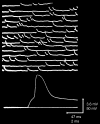Bernard Katz, quantal transmitter release and the foundations of presynaptic physiology
- PMID: 17068096
- PMCID: PMC2151334
- DOI: 10.1113/jphysiol.2006.123224
Bernard Katz, quantal transmitter release and the foundations of presynaptic physiology
Figures


Comment on
-
Quantal components of the end-plate potential.J Physiol. 1954 Jun 28;124(3):560-73. doi: 10.1113/jphysiol.1954.sp005129. J Physiol. 1954. PMID: 13175199 Free PMC article. No abstract available.
-
Spontaneous subthreshold activity at motor nerve endings.J Physiol. 1952 May;117(1):109-28. J Physiol. 1952. PMID: 14946732 Free PMC article. No abstract available.
References
-
- Isaac JT, Nicoll RA, Malenka RC. Evidence for silent synapses: implications for the expression of LTP. Neuron. 1995;15:427–434. - PubMed
Publication types
MeSH terms
Substances
Personal name as subject
- Actions
LinkOut - more resources
Full Text Sources

